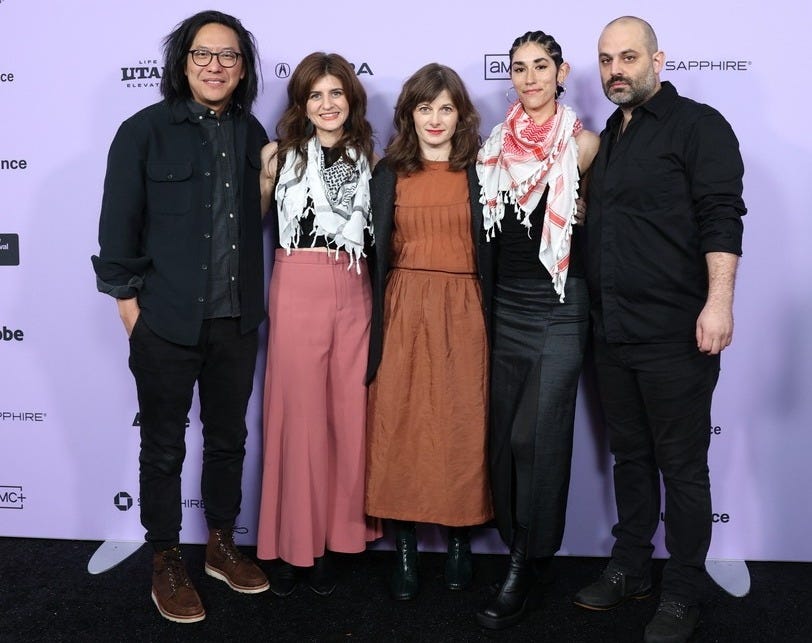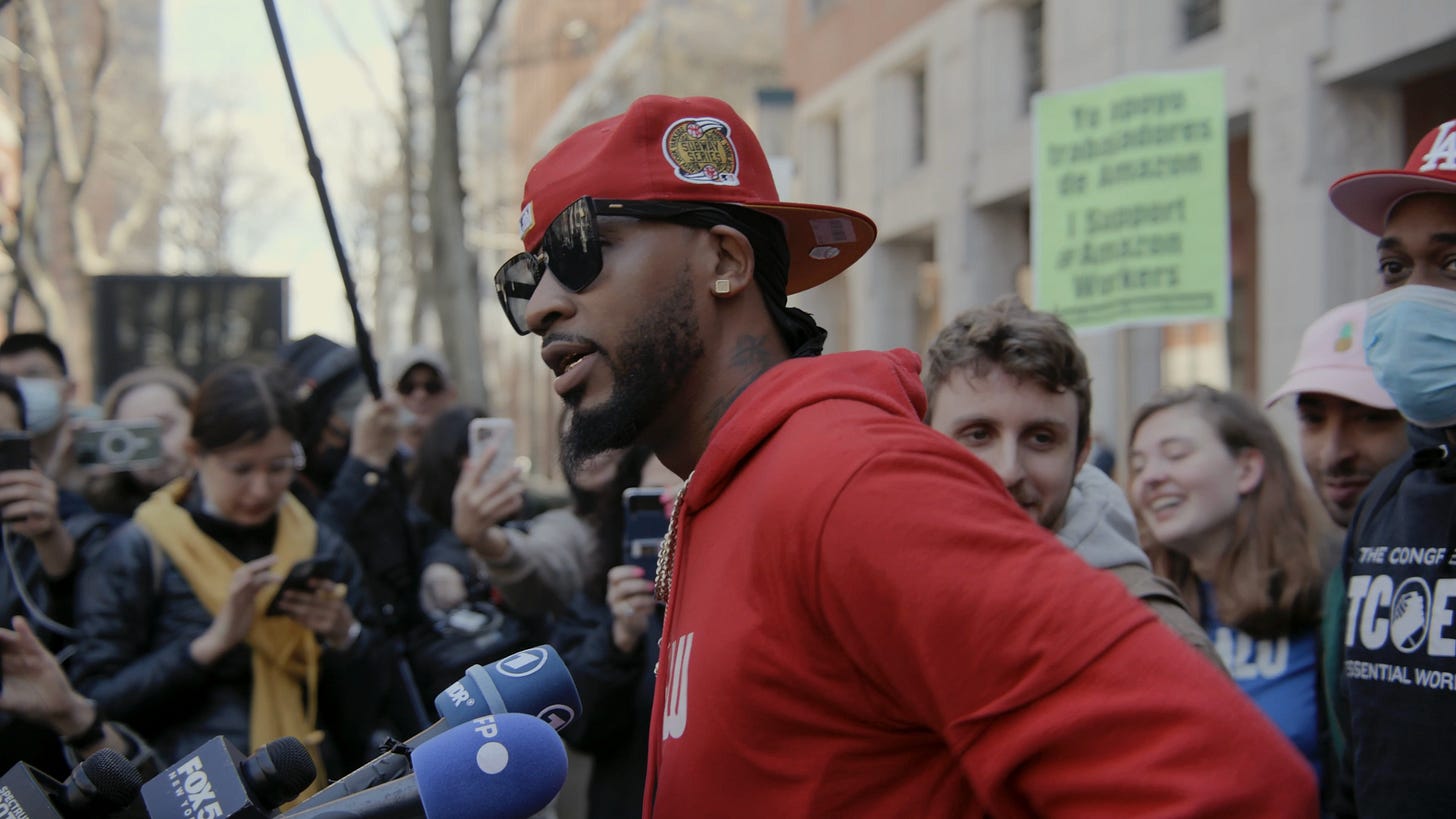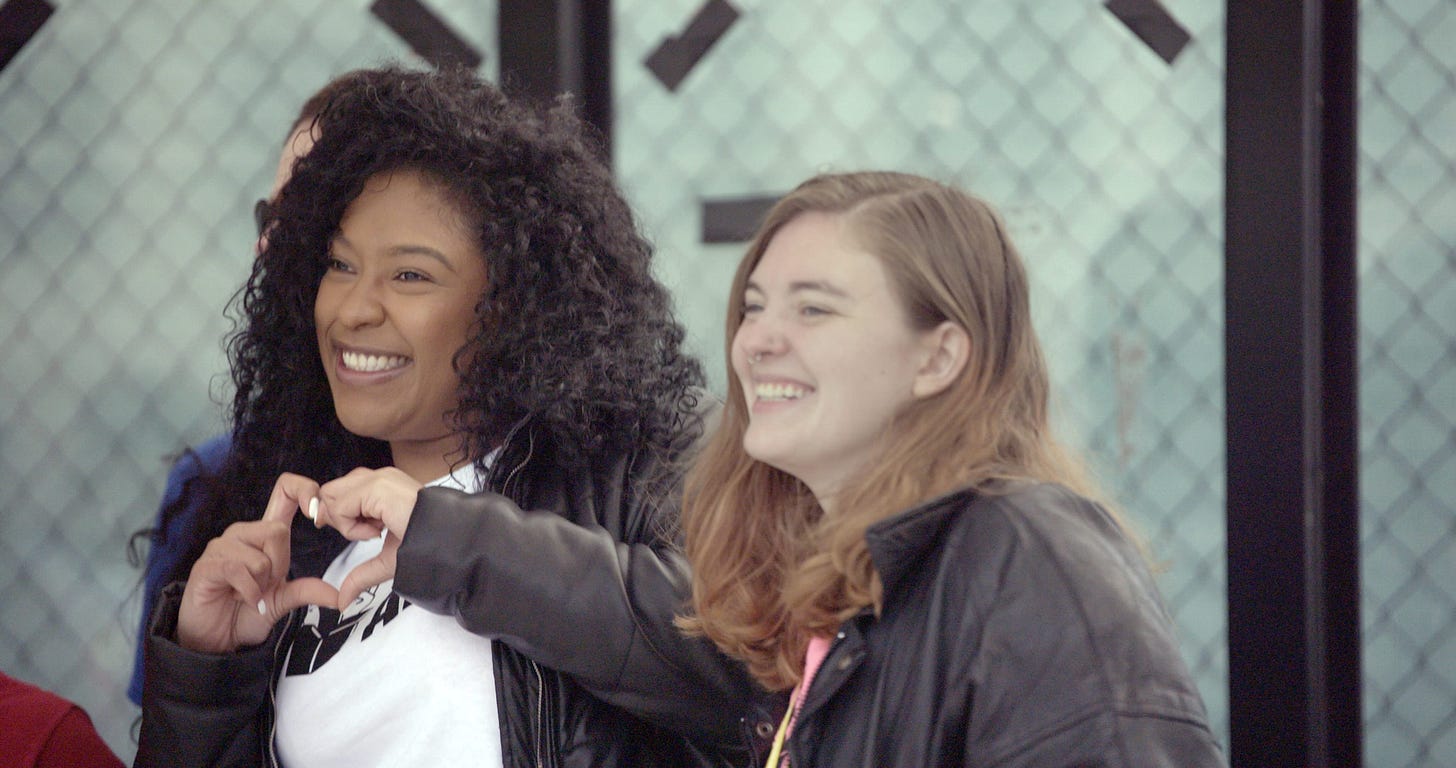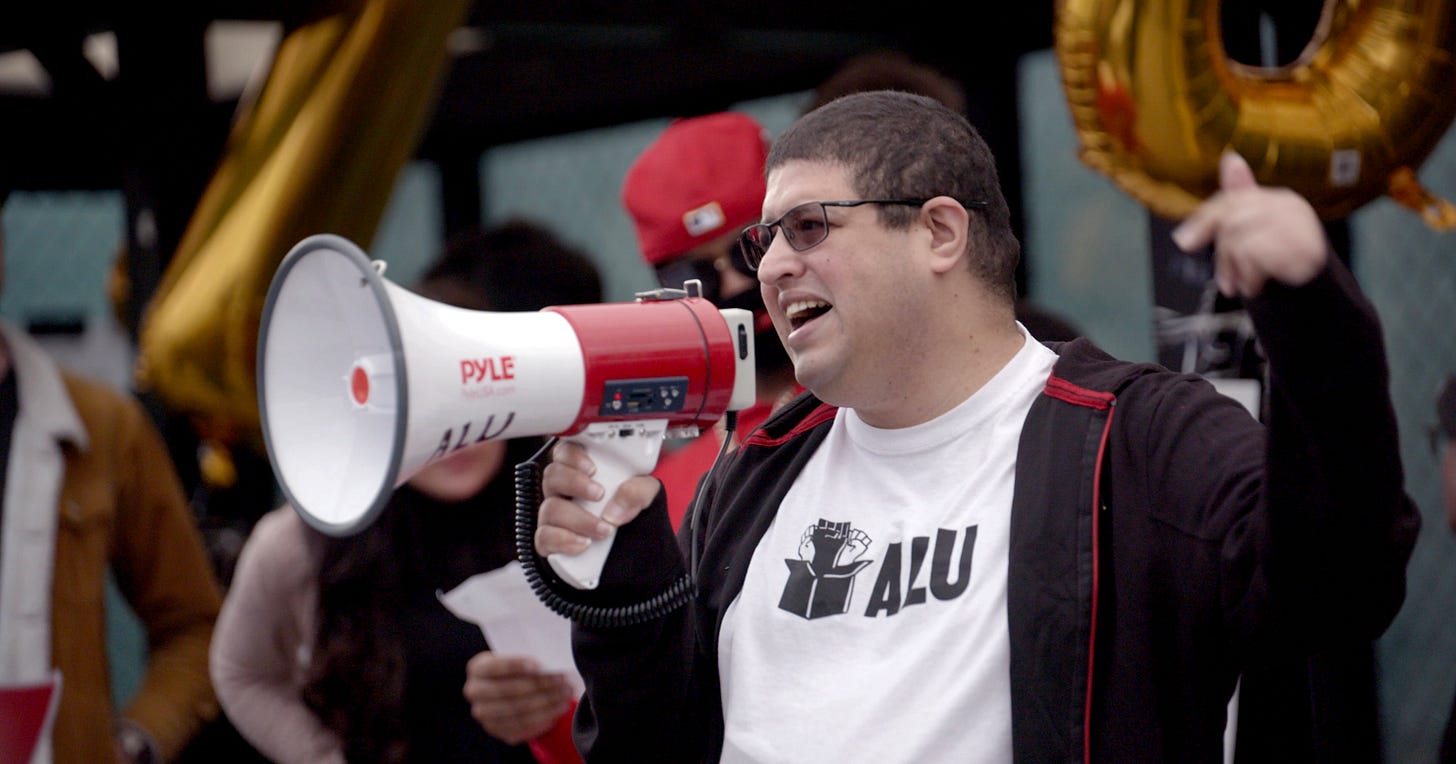Against All Odds: How 'UNION' Won Twice—On Screen and Off
Even though the win isn't perfect, there is a lot to celebrate about the journey of filming the rise of the Amazon Workers Union to today's POV premiere...
Dear Readers,
The documentary UNION is available starting today on POV- here is how to watch. My recent conversation with director Stephen Maing and producer Samantha Curley delved into the five year process of taking the film from a kernel of an idea to filming 800 hours to today’s broadcast premiere. The story of the film, both onscreen and off, feels incredibly timely so I am writing a two part series on it. Here we go…
When the lights dimmed on a frigid January afternoon at Sundance 2024 and the documentary UNION flickered to life on screen for the first time, audiences witnessed how a small band of workers inside Amazon's massive JFK8 warehouse pulled off the impossible during the height of COVID….
…they won their fight to become the first ever worker’s union at an Amazon warehouse.
After the premiere, the energy in the room was electric. People were left inspired and hopeful by the film and the energizing Q&A. And the industry folks in the room (including me) looked around to check what buyers were there to witness this successful premiere screening...
Who would make an offer??
Not Amazon, but maybe another buyer looking for a film that speaks to a broad audience and relatable to anyone who has ever held down a job?
It's crazy how as recently as January 24, 2024, it wasn't naive to think a film like this had a chance of being acquired at a festival. The film team certainly believed they might land a sale—especially after the movie won an award at the festival and received glowing press coverage.
But after we all packed up our snow boots and headed home with post-festival sniffles, there were no major offers.
What happened to UNION after Sundance became its own unexpected story. When major distributors passed on the film, the creative team decided to take matters into their own hands. They mounted a grassroots distribution campaign that proved as determined and strategic as the union drive they had documented. But before we dive into that, let's rewind the tape to learn how this documentary came to be.

The story of UNION runs much deeper than simply not getting bought at Sundance...
Producers Samantha Curley and Mars Verrone originated the project that would become UNION together in 2020 after they had both reached out separately to labor organizer Chris Smalls. Curley had met him during the early days of the pandemic in organizing circles. Verrone reached out after Smalls gained national attention when he organized a walkout at Amazon's Staten Island warehouse (JFK8) to protest what he called inadequate COVID-19 safety protocols.
Even though Verrone and Curley didn't know each other, they decided to join forces to build a documentary together. Curley shared, "We had a theme around essential work and essential workers, thinking about the connections between labor and movements for racial justice that were happening during the pandemic." They didn't yet know what story the film would capture- the plans to unionize at JFK8 hadn’t materialized yet.
It can be almost impossible to raise money at an early stage of making a documentary, especially when you only have a topic or a few potential characters but no clear narrative arc.
Developing documentary projects always feels like a version of the chicken-and-egg paradox.
Yet there's something that can be even harder than raising early money: getting people in sensitive, high-risk situations to allow cameras into their lives—and even more so for independent filmmakers without big names or distribution already attached.
In fact, Chris Smalls had already lost his job at Amazon after the walkout and was already the subject of intense media attention. So why did Chris Smalls and his co-organizers agree to let an indie film team start following them around with cameras?
Verrone and Curley's relationship with the film's subjects began by demonstrating their commitment to the cause of workers' justice. Curley explained: "One of the first things we did in this relationship-building phase of the project—Mars and I helped organize a protest that Chris was doing in LA at Jeff Bezos's house." As the documentary project moved forward, Curley and Verrone were upfront about their support of the cause and became well known to Smalls and the co-founders of the Congress of Essential Workers (Derrick Palmer, Gerald Bryson, and Jordan Flowers), who went on to form the Amazon Labor Union.
There are many aspects of making this documentary that echo the themes of forming a union. First, Curley and Verrone joined forces instead of competing with each other for Smalls' participation in a documentary. Then they built a filmmaking team that shared their political and artistic values, including directors Brett Story and Stephen Maing.
"Obviously [making a film] is a very different project than starting a union, but it's highly collaborative," Curley said. "There can be a lot of tension and conflict and highs and lows. I think the way we moved through it as a film team [made us] able to really connect with the participants. Like, we're doing this thing too."
Capturing Truth at the Hot Dog Stand
While Maing and the film team share the same politics as their subjects, they did not want to simply tell a warm and fuzzy story about a labor movement. Maing explains, "When I turn the camera on, I try to put aside all of my political alignment and turn on a different set of receptors."
So much of documentary filmmaking, especially for verite films like this one, involves standing around with a camera. Often, the story you came for isn't the one you end up telling. The real story emerges only after you invest hours, days, months...
"The first several months of filming in my experience was deceptive in its simplicity - people in a tent handing out hot dogs and flyers," said Maing. "What started to slowly emerge were very candid conversations about politics, labor or working conditions."
What Maing and co-cinematographer Martin DiCicco captured at the tent was the humanity and unique texture of this unionization effort. Throughout the film, we see the organizers connecting with workers through small acts: handing out food, talking about their everyday experiences. In one of my favorite scenes, an organizer gives marijuana to a woman who is obviously stressed. She happily accepts it, and the scene plays as a moment of two strangers coming together and bonding over their shared need for stress and pain management. We see how these moments of care and connection in turn build trust and help their cause.
Even though there are these touching moments, the film never feels like a promotional video for the ALU. Instead, this film is an honest portrait of a diverse group of people from different backgrounds trying to work together. Curley elaborates, "One of the many interesting things about the Amazon Labor Union and the workers that are in our film is that they fall on very different political lines and spectrums in terms of who they vote for, what kinds of policies they believe in or would advocate for. The common denominator really was and is dignity for the working class. And so it is political, but it's political in a very different kind of way."
Maing continues, "This is also a story about a group of organic workers at Amazon supported by a group of salts—a very rich dynamic of different kinds of organizers coming together." ( In labor organizing, a "salt" is a union organizer who gets hired at non-union workplaces specifically to organize workers from the inside, “salting” or seeding the the unionization message from the inside.) For example, the group fighting Amazon in the film includes Derrick Palmer, a Black Amazon employee who joined the fight after his treatment during COVID, and Madeline Wesley, a recent college graduate who never worked at a warehouse but who joins the fight because of her belief in the cause. They are a diverse group, from their ethnicities to their opinions about the best way to unionize.
The history of labor movements in the United States is characterized by persistent racial and class tensions. Full disclosure: I was an Executive Producer of The 1619 Project documentary series. Since The 1619 Project's goal is to connect present-day issues to history, we did an episode on U.S. capitalism that looked at the history of race and labor. One section of that episode featured historian Robin D.G. Kelley, who explains how racism has weakened all workers' rights over time. The "hidden secret of racial capitalism's longevity," as Kelley puts it, is that if laborers from all racial and ethnic groups joined forces, they would have significantly more power to fight for their rights. Therefore, it serves capitalists' interests to keep racial groups divided so that they have the upper hand.
Indeed, the filmmakers knew the story they were filming was not a unique one. Maing explains how they tried to imbue this context into the film:
Black radical and white working-class movements share entwined histories that represent capitalism’s greatest threat. I think it was important for us to acknowledge how the work is very much not done but when these movements unite, these pockets of resistance don't just challenge individual companies—they expose the fundamental vulnerability of a system that depends on racial division to maintain economic control.
Ultimately, the film reaches its emotional peak when the efforts to unionize come to fruition. On April 1, 2022, the Amazon workers at JFK8 became the first unionized Amazon workers in the U.S. recognized by the National Labor Relations Board.
But once they started editing the film, Curley said they worked hard not to make it a David vs. Goliath narrative.
"We're so trained in these documentaries and in these stories to track the hero's journey, to track the sports victory metaphor." So they didn't want to overplay the group's tensions or their win. "I think in the final film, there are maybe three scenes of internal conflict. That really was enough to make people in the movement feel like, 'Oh my gosh, they're actually representing what it really looks like and feels like.' And for people not in the movement to understand this isn't actually just two best friends beating Amazon."
The movie ends with a sobering update to the story....while the ALU's victory marked the first unionized Amazon workplace in the US, the company still refuses to begin negotiating a contract for workers. Even now, 3 years after the win, the company still refuses to sit down with the union to make an agreement.
Now on to... Art, Stories, Politics, Journalism, and Truth
There is this place I call documentarians' Bermuda Triangle. It's a place where it's easy to get lost as we chart a path toward telling a good, true story. Why? It can be tempting to prioritize a juicy, perfectly timed storyline over the actual sequence of events that isn't as fun to watch. It's seductive when you make a beautifully crafted documentary that perfectly lines up with your political ideology, even though that means leaving out a valid critique. Honestly, after having worked with and fact-checked hundreds of documentaries while at The New York Times Op-Docs, it's rare for documentarians to prioritize fidelity to the truth over their desire to tell a good story and make a point. But it is also important to understand the ethics and perspectives on different methods of truth seeking.
While working at NYT, I saw how the practices of journalism and documentary filmmaking overlap. Both fundamentally seek to reveal new truths about our world by telling true stories. But the methods, rules, and goals do differ. For one, being as upfront and honest as the UNION team was about their politics would get them fired in many newsrooms. (But not on the opinion side!)
So I think the example of UNION and its filmmaking team is an important case study of why filmmakers being open about their political goals does not necessarily disqualify a film from being truthful. Maing is honest about the ethical complexities of this work.
"To bear witness as a film team put us in a very complicated position at times because it's the classic journalistic photo of the vulture by the baby. In some situations you want to intervene, you want to help out or be involved. And yet, it was not our role to steer this movement organization."
While I do strongly believe the role of objective (as possible) journalism is crucial in finding truths, filmmakers access another equally important, yet different, kind of truth through their different forms of practice.
Making as real and intimate a portrait of this movement as UNION captured probably wouldn't have happened without the access gained by the UNION filmmakers' alignment with their subjects' cause. Since the film team was upfront about their politics, they were let into the tent.
Another key point is that they also spent a lot of time inside the tent.
On a practical level, daily news reporters rarely have the luxury of time like filmmakers do to sit with their subjects to find unexpected truths through building long and deep relationships with their subjects. Maing talked about witnessing the difference up close between their process and how some daily news outlets covered the story. “Many media airdropped in to grab their organizing shots - sometimes asking leading questions to get a sound bite. But for us, we were more interested in a fundamental experience - how they existed within and were challenging these structures of power." In contrast, the UNION production team filmed 800 hours with their subjects to make their film. So of course the final products are worlds apart in what they reveal about the state of humanity.
How Did the Amazon Labor Union React to the movie?

It's always informative to know what subjects think of their portrayal in a documentary. But I was particularly interested in what this group thought of theirs. On the one hand, the film team had gained access partly by communicating their honest affinity for workers' rights. But the final film isn't simply a love letter to them and the cause.
"We were really clear and upfront and definitely practiced ongoing consent to keep people updated and informed about what filmmaking means and how the process works," Curley explained. "And so I don't think anybody was surprised to see some of the harder moments in the film." They also hired lawyers to vet the film to make sure it didn't impact anyone's employment.
While some of the participants did find it challenging to see their lives edited into an hour and forty minutes, no one asked for any changes when they saw the film. Maing observed the subjects as they watched.
“I’ll never forget Chris during the screening when Maddie and Nat are debating whether a big union is going to come to save them. Nat is trying to convince Maddie that she may be putting her confidence in the wrong team. After Maddie defends Chris and the union I hear him say under his breath, 'Wow, I had no idea she said that.' I sensed he was really moved.”
Now, the film subjects are still engaged with the film through its release. All of the main subjects have traveled to screenings and have been part of Q&As since Sundance, paid for by the film.
Money Talk
Since the film team worked hard to make the experience of being part of UNION positive, I wondered how they handled the question of money. Whether or not to pay documentary subjects is a hot topic in our field right now. Some documentarians pay subjects. For example, some pop stars get paid for the use of their songs. Hurricane victims might get paid for their home movies. Some filmmakers pay subjects for their time.
The UNION team did not pay their subjects during production. But they did commit to supporting their cause for the long haul, and the film team has boosted their political work alongside the doc. Curley is also working on a financial model for UNION and future projects that includes in the distribution and impact budgets a way to pay participants when and if a film is successful. Her idea is to create honorariums that are calculated as a proportion of the distribution revenue. Since UNION was made collaboratively, the team all agrees this is the right way to treat their subjects.
Also, we all agreed that there is no simple rubric for how to deal with money and subjects.
"I don't think that there's a one-size-fits-all kind of approach to the participant payment or participant reimbursement question," Maing said. For certain projects, paying a subject would undermine the integrity of the work completely. "If there's any investigative element to the work you're doing, forget about it..."
Paying subjects opens a Pandora's box of ethical conundrums. When you pay subjects during production, it changes the dynamic: they are essentially working for you now. Will they act for the camera? Perform what they think you want? However, in some cases paying may seem ethical. For instance, if you are asking someone to skip work for a shoot, should you compensate them for the hours missed? What if a documentary ends up being a financial success? When Steve James made Hoop Dreams, neither he nor his subjects ever imagined it would become a mega hit. But after it did, James shared some of the proceeds with his key subjects in ways that changed their lives for the better. However, it would be totally irresponsible to tell documentary subjects early on that this was a possible outcome. But subjects do ask about money, and filmmakers need to be prepared to have honest conversations with their subjects about it.
Maing did discuss with the subjects of UNION that documentaries can, but rarely, become profitable. He advises all filmmakers to bring up this rare possibility early in the process before subjects ask about it. “We try to make it clear that if there is money to be made on this, our team will not forget or devalue how important it was for you to have been a part of the making of this film."
Five Years
In the end, the team made an artful and political film without losing sight of their ethics. It received good reviews, is 88% fresh on Rotten Tomatoes, is inspiring political action, and is reaching audiences worldwide.
But of course, there is more to the story. The film ended up costing $1.4 million to make. And no one bought it for $1.4 million in the end.
So how did the film make it out into the world between Sundance and the POV broadcast?
Would they make a film for $1.4 million again, or is that an unrealistic budget post-boom?
Given all the obstacles, how do they plan to move forward as documentarians?
Their candid, and not all depressing, takeaways from making the film are coming on Thursday….








